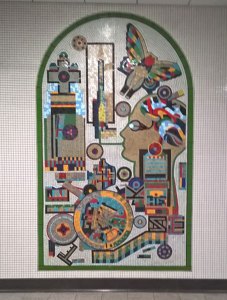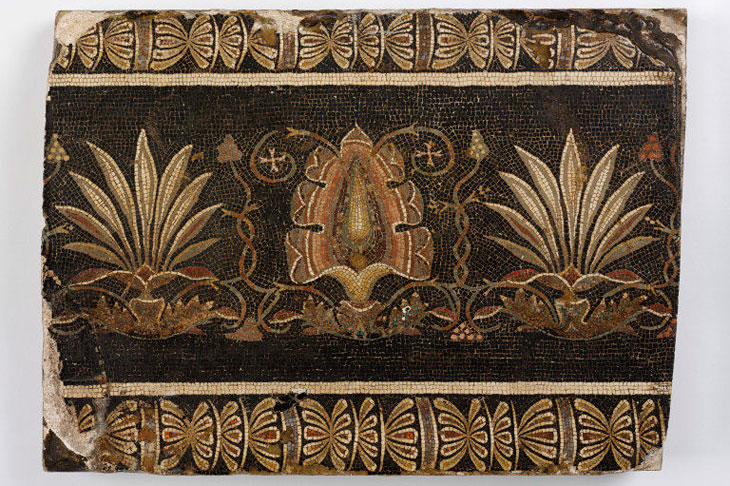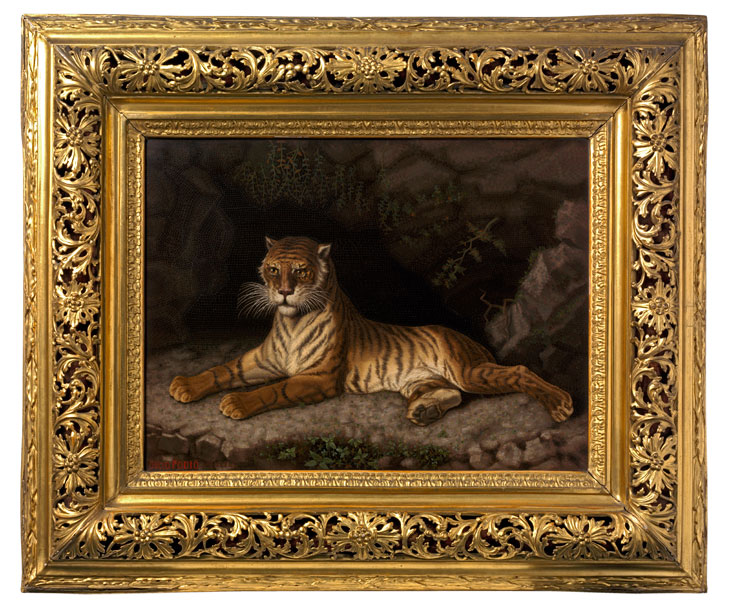How many of the 150,000 passengers who use Tottenham Court Road tube station each day pause to consider the origin of the art-form which enlivens their journey? The spectacular mosaics by Eduardo Paolozzi, originally installed in 1986, have been carefully restored on the walls of the Northern and Central Line platforms, with another portion moved underground from its original site at the station’s Oxford Street entrance. These brightly coloured confections celebrate popular culture, from jazz to science fiction.

One of Paolozzi’s mosaics at Tottenham Court Road. Photo: courtesy the author
Mosaics are perfect for public spaces; their durable materials withstand centuries of weather, wear and tear. An impressive group of them can be found a short journey from Tottenham Court Road at the Victoria and Albert Museum, which will celebrate the versatile medium with a major conference this Saturday 24 June. Leading experts and practitioners will explore the art-form’s sacred and secular history, via Byzantium through the Renaissance and the Grand Tour to exciting recent commissions for the New York subway.
The oldest mosaic in the V&A was probably made in Pergamon in the 2nd century BC and later installed in the grounds of Emperor Hadrian’s (r. 117–138 AD) villa at Tivoli. It forms part of the border of the fascinating ancient mosaic described by the natural historian Pliny the Elder, which depicted four doves perched on the edge of a metal bowl filled with reflective water. This version of The Doves of Pliny (there is not a consensus as to whether it is the original, or a high quality secondary version) was uncovered in April 1737: mounted on a stone slab, it was lifted from the ground soon after. The central section ended up on display in Rome, while the outer border was cut into several small panels for use as diplomatic gifts to rulers including Augustus the Strong (1670–1733) and Louis XV of France (1710–74).
The V&A’s fragment demonstrates the illusionistic effects that Pliny so admired: its delicate floral motifs and rows of beads are depicted through judicious placing of tesserae (the small cubes of which mosaics are made) in stone, glass and faïence. Stolen in the late 20th century, it was recovered in Berlin in the 1990s and now introduces this ancient technique in the V&A’s Gilbert Galleries, which are also home to detailed micro-mosaics from the Gilbert Collection, including a later version of The Doves of Pliny by Giacomo Raffaelli. Nearby, a micro-mosaic landscape view (c. 1820) made by Giovanni Morelli for the tourist market reminds us that in addition to Hadrian’s Villa, the natural landscape and Renaissance gardens at Tivoli were a ‘must-see’ on the Grand Tourist route.

Mosaic fragment of the ‘Doves of Pliny’. Photo © Victoria and Albert Museum
As Paulo di Buono (director of the Vatican Mosaic Workshops) will explain on Saturday, mosaics were adopted by the Vatican in the 16th century as the most practicable technique for rendering the altarpieces for the many chapels of St Peter’s, where paintings succumbed to the damp. At much the same time, Francesco Zuccatto’s St Jerome in the Wilderness (1566), made after a composition by Titian, won a contest organised by the authorities of St Mark’s, Venice, to find the best mosaic craftsman in the region. (The Master Mosaicists by French author George Sand recounts the story.) St Jerome is shown penitent, dishevelled and semi-naked, kneeling in the desert with a rock in his hand to beat his breast, with a crucifix and skull nearby. He is identified by his attributes, a cardinal’s hat and a lion.
Animals have always been popular subjects for mosaics – they made for decorative wall pictures and fascinating miniatures for the lids of gold boxes. My favourite is The Tigress by Decio Podio, a 19th-century Venetian mosaicist whose subject is the Bengali animal given by Clive of India to the 4th Duke of Marlborough for the menagerie at Blenheim Palace, Oxfordshire. The mosaic is based on an engraving after George Stubbs. Podio – a relative of Salviati, the director of leading Venetian mosaicists at that time – has outlined the tigress in black tesserae compelling the subject into the viewers’ space.

The Tigress 1850–1900), Decio Podio. © Victoria and Albert Museum
‘Micro and Other Mosaics’ takes place at the Victoria and Albert Museum on 24 June, 2017.














![Masterpiece [Re]discovery 2022. Photo: Ben Fisher Photography, courtesy of Masterpiece London](http://zephr.apollo-magazine.com/wp-content/uploads/2022/07/MPL2022_4263.jpg)
‘Like landscape, his objects seem to breathe’: Gordon Baldwin (1932–2025)